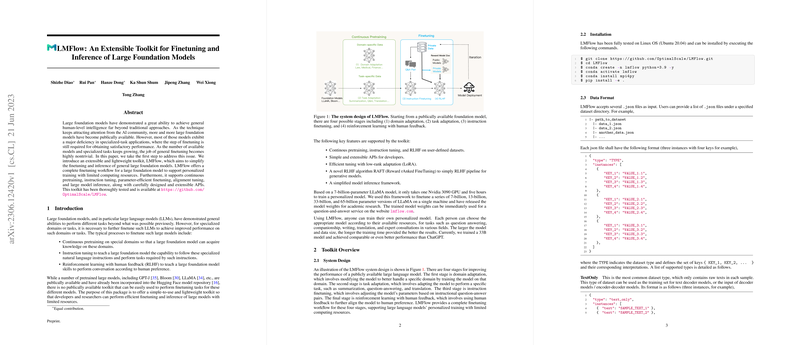Overview of the LMFlow Toolkit for Finetuning Large Foundation Models
The paper introduces LMFlow, a toolkit designed to streamline the finetuning and inference processes for large foundation models, particularly focusing on LLMs. The authors address the challenge of adapting these models to specialized tasks, acknowledging that despite the general capabilities of foundation models, domain-specific finetuning remains indispensable.
Key Features and Contributions
LMFlow is positioned as an extensible and lightweight toolkit, with the following salient features:
- Comprehensive Finetuning Workflow: It supports continuous pretraining, instruction tuning, and reinforcement learning with human feedback (RLHF). This comprehensive approach enables users to perform domain adaptation, task adaptation, and alignment tuning effectively.
- Efficient Resource Utilization: The toolkit is designed to work efficiently with limited computational resources. For instance, it allows the personalization of a 7-billion-parameter model using a single Nvidia 3090 GPU in a matter of hours.
- Low-Rank Adaptation (LoRA): By incorporating LoRA, LMFlow offers parameter-efficient finetuning, reducing the number of trainable parameters while maintaining model performance.
- Novel Reinforcement Learning Approach: The paper introduces a new algorithm, Reward rAnked FineTuning (RAFT), which simplifies the RLHF pipeline. RAFT allows for the continuation of training using SFT-like techniques, providing stability and computational efficiency over traditional PPO methods.
Numerical Results and Claims
In task tuning, LMFlow demonstrates notable improvements in the medical domain using models such as the LLaMA series. For example, the LLaMA-33B model, with LoRA finetuning, achieved significant performance enhancements in medical QA tasks. Furthermore, the Robin models, derived from extensive instruction tuning, performed competitively on the Huggingface Open LLM Leaderboard, indicating the effectiveness of the toolkit in instruction-following tasks.
Implications and Future Directions
Practically, LMFlow enables researchers and developers to rapidly adapt large models to diverse tasks using limited resources. Theoretically, the introduction of RAFT hints at a more stable and resource-efficient method for aligning models to human preferences.
Future work may include expanding LMFlow's capabilities to other domains and integrating more sophisticated techniques for instruction and alignment tuning. As LLMs evolve, the need for flexible and efficient finetuning tools like LMFlow will likely increase, underscoring its potential impact in the AI community.
By democratizing access to advanced finetuning capabilities, LMFlow stands to significantly influence how LLMs are adapted and applied across various specialized applications.
